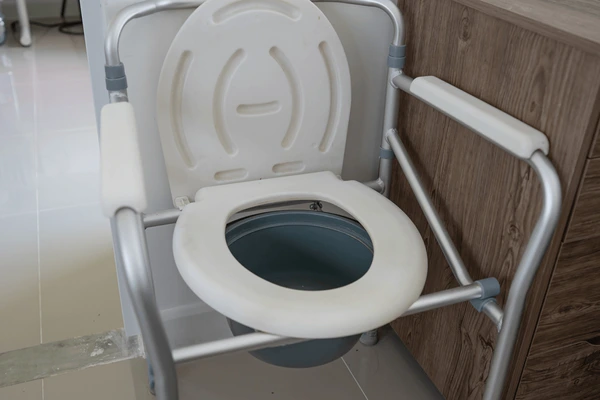For many people with limited mobility, using the bathroom can be one of the most challenging—and potentially risky—daily activities. Slippery floors, low toilet heights, and the effort required to transfer safely can all increase the risk of falls. Fortunately, simple adaptive equipment such as bedside commodes and toilet safety frames can make a big difference in promoting independence, dignity, and safety.
Why Bathroom Safety Matters
According to health studies, bathrooms are one of the most common places for falls at home. For individuals recovering from surgery, living with chronic conditions, or experiencing age-related weakness, getting to and from the toilet may feel overwhelming. Bathroom safety aids help by:
- Reducing the risk of falls and injuries
- Making toileting more accessible
- Decreasing caregiver strain
- Preserving independence and privacy
Bedside Commodes
A bedside commode is a portable chair with a toilet seat and a removable bucket. It can be placed beside the bed or used over an existing toilet.
Types of Bedside Commodes:
- Standard Commodes: Simple frames with a seat and bucket, ideal for use near the bed.
- Drop-Arm Commodes: Arms that swing away for easier side transfers from a bed or wheelchair.
- Wheeled (Rolling) Commodes: Can be pushed like a transport chair, convenient for moving between rooms.
- 3-in-1 Commodes: Versatile designs that can serve as a bedside commode, toilet safety frame, or raised toilet seat.
Benefits:
- Convenient for those with limited mobility or nighttime needs
- Reduces urgency-related accidents
- Eases caregiver assistance with toileting
Toilet Safety Frames
A toilet safety frame is a supportive structure that attaches to or surrounds the toilet, providing sturdy armrests for easier sitting and standing.
Key Features:
- Adjustable height to fit different toilets
- Slip-resistant grips for added security
- Freestanding or attachable options
Benefits:
- Provides balance and stability
- Reduces the effort of lowering and standing
- Enhances confidence for those with weakness or balance issues
Choosing the Right Equipment
When selecting a bedside commode or toilet safety frame, consider:
- Mobility level: Can the person walk to the bathroom, or do they need a commode by the bed?
- Space available: Some frames and commodes are compact, while others require more room.
- Caregiver support: Drop-arm or rolling commodes may make transfers easier for caregivers.
- Comfort and dignity: Cushioned seats, adjustable heights, and removable parts can make a big difference.
Safety Tips
- Always lock the brakes on rolling commodes before transfers.
- Place commodes on a stable, flat surface to prevent tipping.
- Ensure toilet safety frames are secured properly before use.
- Keep the bathroom well-lit and clutter-free.
Final Thoughts
Bedside commodes and toilet safety frames are simple yet powerful solutions that improve bathroom safety, comfort, and independence. Whether you’re caring for a loved one at home or planning for your own future needs, these aids can make everyday life safer and less stressful.
For personalized guidance, an occupational therapist or home healthcare professional can recommend the right equipment based on individual mobility and home setup.

